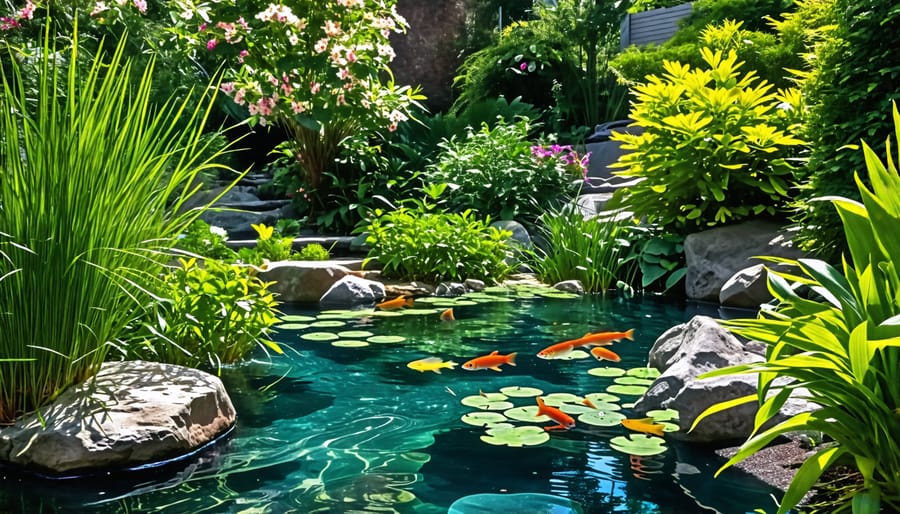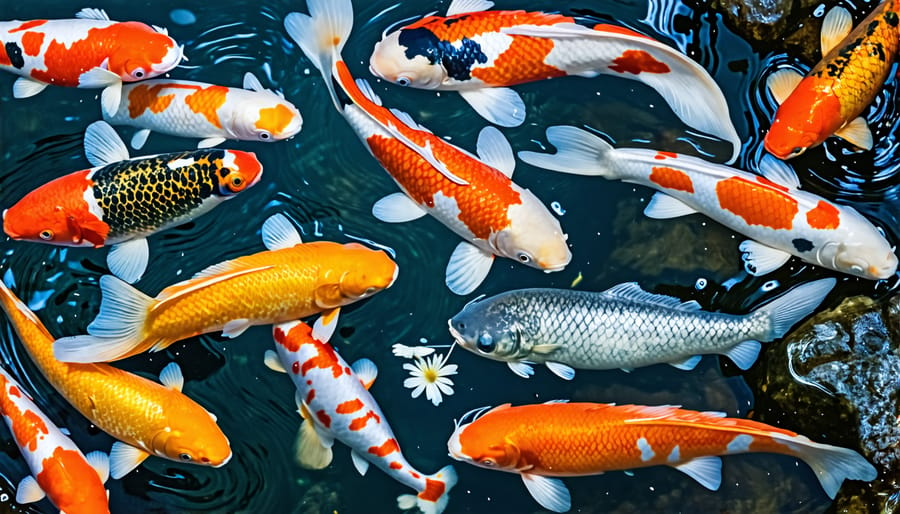
Create Your Dream Pond: The Ultimate Guide to Thriving Fish
Establish a balanced ecosystem by maintaining proper water chemistry, incorporating natural filtration through aquatic plants, and ensuring adequate aeration. Select fish species well-suited to your pond’s size, climate, and existing inhabitants, stocking them at appropriate densities. Provide a varied, nutrient-rich diet tailored to each species’ needs, offering small amounts multiple times daily and adjusting portions based on consumption. Regularly monitor fish health, promptly addressing signs of disease or stress through quarantine, targeted treatments, and optimizing environmental conditions.

Choosing the Right Fish

Popular Pond Fish Species
Koi and goldfish are among the most popular choices for pond fish, beloved for their vibrant colors and friendly personalities. Koi come in a stunning array of patterns and hues, with some prized specimens fetching impressive prices. These gentle giants can grow up to three feet long and live for decades with proper care. Goldfish, on the other hand, are a more budget-friendly option that still bring plenty of charm to your pond. From the classic orange to calico and black moor varieties, there’s a goldfish to suit every taste.
For a more natural look, consider stocking your pond with native fish species. Not only do they blend seamlessly with the local ecosystem, but they also tend to be hardier and better adapted to your climate. Fathead minnows, golden shiners, and mosquitofish are all excellent choices that help keep mosquito larvae in check. Bluegills and perch are larger options that add interest and can even provide a tasty treat if you decide to cast a line.
When selecting fish for your pond, it’s important to consider their specific needs. Koi and goldfish prefer cooler temperatures and require a depth of at least three feet to overwinter successfully. They also produce more waste than other fish, so adequate filtration is a must. Native species generally have simpler care requirements, but it’s still crucial to research their preferred habitat and diet.
Regardless of the species you choose, all pond fish benefit from a well-balanced ecosystem. This means plenty of oxygenating aquatic plants, proper filtration, and regular water quality testing. Overfeeding is a common mistake that can lead to health issues, so be sure to provide only what your fish can consume in a few minutes, once or twice a day. With a little research and attention to detail, you can create a thriving underwater world that brings joy for years to come.
Stocking Density and Ratios
When stocking your pond with fish, consider its size and the species you want to keep. A good rule of thumb is to allow 1 inch of fish per 10 gallons of water. For example, a 500-gallon pond could comfortably accommodate around 50 inches of fish. Keep in mind that fish grow over time, so don’t overstock initially.
Aim for a balanced community by including a variety of species that occupy different levels of the pond. Bottom-feeding fish like koi and goldfish help keep the pond clean, while surface-dwelling fish such as orfe and rudd add visual interest. Incorporate some algae-eating fish like plecos or otocinclus catfish to control green water.
Avoid mixing aggressive species with peaceful ones, as this can lead to stress and injuries. Research the compatibility of different fish before adding them to your pond. Introduce new fish gradually to allow the existing population to adjust and minimize territorial disputes.
Remember, less is often more when it comes to stocking density. An overcrowded pond can lead to poor water quality, increased disease risk, and stunted fish growth. By maintaining a balanced and appropriately sized fish community, you’ll create a thriving ecosystem that brings joy for years to come.
Feeding Your Fish
Types of Fish Food
When it comes to feeding your pond fish, you have several options to choose from. Pellets are a convenient and nutritionally balanced choice, available in floating or sinking varieties to cater to different feeding preferences. Flakes are another popular option, especially for smaller fish, as they are easy to consume and distribute evenly across the water surface. Live foods such as brine shrimp, daphnia, and bloodworms provide a more natural and engaging feeding experience, stimulating the fish’s hunting instincts. However, live foods can introduce diseases if not sourced carefully. Greens like lettuce, spinach, and peas (with the skin removed) offer a healthy supplement to your fish’s diet, providing essential vitamins and minerals. It’s crucial to remove any uneaten greens promptly to prevent fouling the water. Whichever food types you choose, be sure to use high-quality options and avoid overfeeding, as excess nutrients can lead to water quality issues. Installing pond filters can help maintain a clean and balanced environment for your fish to thrive. Variety is key in providing a well-rounded diet that meets your fish’s nutritional needs while keeping mealtimes interesting and enjoyable.
Feeding Schedule and Quantity
Feeding frequency and amount depend on several factors, including water temperature, fish species, and size. In general, feed pond fish once or twice daily when water temperatures are above 50°F (10°C). Offer only what they can consume within 5 minutes to avoid overfeeding and maintain water quality. For smaller fish, provide food that is easily consumed, such as flakes or small pellets. Larger fish require bigger pellets or sticks. Adjust feeding amounts based on fish activity and appetite. During colder months when temperatures drop below 50°F, reduce or stop feeding as fish metabolism slows down and they rely on stored energy reserves.
Maintaining Fish Health
Common Fish Diseases and Treatment
Keeping your pond fish healthy involves being proactive about identifying and treating common diseases. Early detection is key, so regularly observe your fish for signs of illness like lethargy, loss of appetite, or visible abnormalities on their skin or fins. One prevalent issue is parasitic infections, such as ich (white spot disease), which manifests as tiny white spots on the fish’s body and fins. To treat ich, gradually raise the water temperature to 86°F for 3 days, then slowly lower it back to normal. You can also add salt to the pond at a ratio of 2.5 cups per 100 gallons to help fish recover.
Bacterial infections like fin rot can cause frayed, ragged fins and open sores. Treat fin rot by improving water quality through partial water changes and adding beneficial bacteria to break down waste. Antifungal medications containing minocycline or erythromycin can be administered as directed. Fungal infections appear as white cottony growths on the fish. To combat fungus, try tea tree oil or methylene blue dips, following package instructions carefully.
If you notice your fish rubbing against objects, they may have flukes (flatworms) irritating their skin. Treat flukes with a formalin bath at a concentration of 250 ppm for 30-60 minutes. Always remove infected fish to a separate quarantine tank for treatment to avoid contaminating the entire pond. Maintain optimal water conditions, avoid overcrowding, and provide a nutritious diet to keep your fish’s immune systems strong and prevent future outbreaks. With vigilant observation and prompt action, you can successfully manage common fish diseases and enjoy a thriving, vibrant pond community.

Seasonal Care Considerations
As the seasons change, so should your approach to pond fish management. In the spring, gradually increase feeding as water temperatures rise above 50°F (10°C). Keep an eye out for any signs of disease or stress in your fish after the long winter.
Summer is the time for growth and activity. Ensure your fish have ample food, but avoid overfeeding which can lead to water quality issues. Monitor water temperatures, as excessive heat can be dangerous for certain fish species. Provide shade and ensure adequate oxygenation.
Fall is a time of transition. As temperatures cool, slowly reduce feeding and perform any necessary pond maintenance before winter sets in. Remove fallen leaves and debris to prevent water quality problems.
In the winter, most pond fish enter a state of hibernation. Stop feeding when water temperatures consistently drop below 50°F (10°C), as fish metabolism slows dramatically. Ensure adequate oxygenation by keeping a small hole in any ice cover. Consider using a pond heater in extreme cold.
Throughout the year, regularly test water quality parameters and make adjustments as needed. Perform partial water changes to refresh the pond environment. Keep an eye out for any signs of disease or distress in your fish, and address issues promptly.
By adapting your seasonal pond care routine, you can provide the best environment for your fish to thrive year-round. With a little extra attention during seasonal transitions, you’ll enjoy a healthy, vibrant pond ecosystem in every season.
